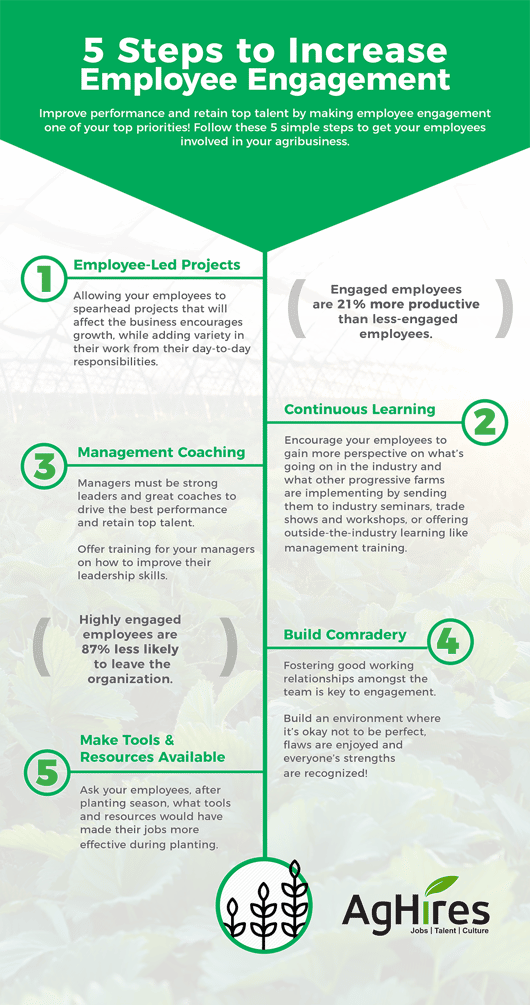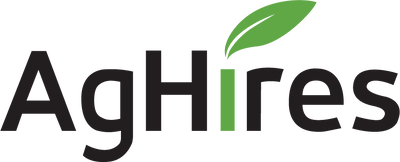
When it comes to improving performance and retaining top talent in our competitive landscape, employee engagement needs to be one of your farm’s top initiatives.
What is employee engagement?
Employee engagement is the level of enthusiasm, commitment, and connection an employee feels towards their work and organization. It's more than just satisfaction, it's a psychological state where employees are involved, passionate, and dedicated to their roles and the company's success. Engaged employees are more likely to go above and beyond, contributing to better performance, higher productivity, and a stronger company culture.
An engaged employee is 14% more productive than a less engaged employee, and contributes to 23% higher profitability. High levels of energy, commitment, and performance from your employees lead to a healthier bottom line.
The return on investment (ROI) on improving employee engagement is higher profitability, fewer errors on the farm, and more creative problem-solving. It’s not about ensuring they are happy every day and enjoy every minute of their job; rather, it’s about having employees that are deeply committed to the success of your operation and put their best foot forward each day.
Let’s look at five practices you can implement with relatively low cost and investment of time to help keep employees engaged.
Employee-Led Projects
Give your employees autonomy to lead projects that will impact the business. This allows employees to grow their knowledge and experience while adding variety to their work outside of their day-to-day responsibilities. Align an employee’s natural talents to useful projects. If you have someone who is very detailed and organized, designate that person to reorganize the shop, adding labeling and shelving as the person sees fit. Or create an employee-led safety committee to implement internal training or improvements to comply with safety standards. Have someone create an internal newsletter or maintain the company Facebook page. There are endless amounts of apps to assist with communication and tracking progress; consider having a team of employees research apps that might be useful for the farm. The extra bonus of employee-led projects is the team is more apt to support what ideas they have developed.
Continuous Learning
Employees are looking to continuously learn and gain knowledge. It benefits the farm when employees have more perspective on what’s going on in the industry and what other progressive farms are implementing. Consider sending them to industry seminars, tradeshows, and workshops. The value comes when you hold a discussion when they return to find out what they learned, found interesting, and what ideas could be applied to the farm. Also consider outside-the-industry training, such as management training, lean manufacturing/continuous improvement, or the 5S technique (which refers to five steps: sort, set in order, shine, standardize and sustain). This helps employees bring in ideas from other industries that can be applied to the farm.
Management Coaching
A big part of whether employees are engaged or not largely depends on the interaction they have with their direct manager. To retain top talent, managers must be strong leaders and great coaches to drive the best performance. Those skills don’t always come naturally to everyone. Provide training for your managers, or perhaps even yourself, on how to improve your leadership skills. I’ve been contacted by farms who want us to hire a manager because, although they have an individual that is great on the farm and execution of work, that person lacks leadership ability. Build your bench strength by training your next-level employees below the management level.
Build Comradery
When a team is connected, the employees’ performance can thrive together. Foster good working relationships amongst the team and build an environment where it’s okay not to be perfect. Build a culture where everyone’s strengths are recognized and flaws are enjoyed. Besides building a cohesive team through day-to-day interactions, treat employees to fun events outside of work, whether you take the team to a ballgame or host a picnic for the families. Celebrate wins and successes along the way, whether it’s a new yield record or simply harvest is complete for the year. Celebrate the hard work everyone has put in. Another great way to connect is to have a service project the team could work on together, such as volunteering or perhaps even hosting a charity event.
Tools and Resources
High-performing employees want to have the tools and resources to succeed. Let’s say you have implemented a new tracking system in the field, and it has some glitches that continually arise. If we don’t work to try to fix the issue for the operator, it ends up being a daily point of frustration. The same goes for having the right equipment to perform employees’ jobs and conduct in-the-moment repairs. Ask your employees what tools and resources they need that would make their jobs more effective.

Focusing on your employee engagement is an ongoing effort. Continuously check in with staff and conduct self-evaluations. Answer these questions as a management team to see how you are doing:
- Does everyone know where we are heading as a company and what matters most to help us get there?
- Does everyone know their role; do they have the tools/resources to do their best in that role?
- What activities have we done to increase the knowledge base of the team?
- Do employees have a voice and are those voices heard by the management team?
- Are we maximizing the unique talents of our team members?
- What’s the trust level between management and the team?
- Have I spent time individually with each employee over the past four to five months to discuss these things?
When we are talking with candidates about potential jobs, they constantly ask us questions about our client’s culture and what it is like to work there. Your company culture plays a large part in the engagement of your employees.
While employee engagement may just sound like a buzzword, it ultimately impacts your farm or ag business’ bottom line. When you have employees who are committed to your organization and their roles, they will be operating at their full potential, allowing your organization to move in the right direction to reach its goals.
For more hiring tips, check out our Employer Blog and YouTube channel.
Written by: Lori Culler, AgHires Founder/Owner





